- Details
- Hits: 1126
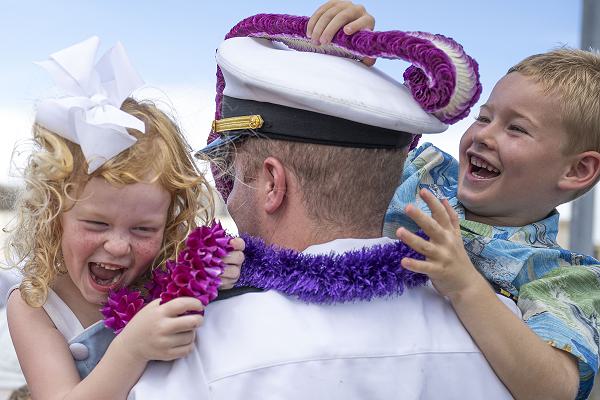
Joint Base Pearl Harbor-Hickam, Hawaii. (August 19, 2024): In this touching photo by Petty Officer 1st Class Scott Barnes, Navy Lieutenant Killian Monley greets his family after returning from a scheduled deployment aboard the Los Angeles class attack submarine USS Charlotte. What most Americans may not realize is the demands we place on our Sailors that keep them far from home for way too long.
Generally, submarine officers like Lt. Monley rotate between sea and shore assignments and they typically spend three years assigned to a specific sub. Depending upon the submarine type, Sailors can expect to be deployed between three and six months at a time which places an enormous burden on their families.
During a deployment, Sailors lose virtually all contact with their loved ones except for an occasional e-mail. This lack of communication is perhaps the hardest aspect of submarine life. It is perfectly normal for families to go weeks, maybe even as long as a month or two, without receiving emails. Sailors can communicate via phone during sporadic port calls that may last from a couple of days to two weeks.
Every command designates the spouse of a sailor to act as an ombudsman for the crew. As a liaison between the command and the sailors’ families, the ombudsman is privy to the latest information about the sub’s return and is also the emergency contact to relay urgent information while the Sailor is at sea. Additionally, each base has a Family Readiness Group staffed by volunteers to be a resource and support system for the families.
Every American should appreciate the sacrifices these Sailor families make defending our nation far from home for extended periods of time.
- Details
- Hits: 1235
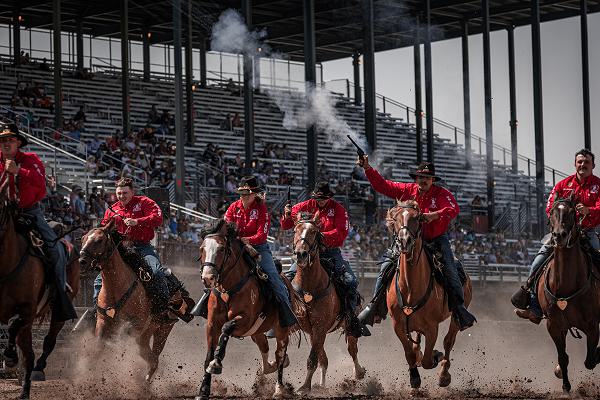
Fort Riley, Kansas. (August 18, 2024): The famed 1st Infantry Division, known affectionately as the Big Red One, has created a modern link to the frontier days of the U.S. Cavalry. In this photo by Specialist Koltyn Omarah, Soldiers assigned to the 1st Infantry Division Commanding General's Mounted Color Guard (CGMCG) ride horses at a rodeo held in Cheyenne, Wyoming. Established in 1992, the CGMCG is outfitted with the uniforms, accessories, and armaments of the Civil War period. The unit performs various drills using the 1861 Cavalry Light Saber, a .45-caliber revolver, and the 1873 Remington .45-caliber lever action repeater rifle. The troopers receive instruction from the actual manuals used by Civil War cavalrymen to recreate the colorful spectacle of the American horse soldier.
The CGMCG performs mounted drill and weapons demonstrations and parades for community events and rodeos, as well as military ceremonies on Fort Riley. The mounted demonstration is an exhibition of the skill and precision required of a cavalry soldier patrolling the frontier.
Experience with horses is not a requirement to become a member of the CGMCG and it is open to both officers and enlisted. The formal tryout lasts eight weeks. The first week introduces the candidates to their horses and they watch an example of a typical rodeo by the experienced Troopers. The candidates must master the basics of horse anatomy and learn stable duties while acquainting themselves with the period’s weaponry and equipment. After completing the eight-week training, candidates will receive their iconic red hat and belt buckle in a ceremony making them part of the historic CGMCG.
- Details
- Hits: 1393
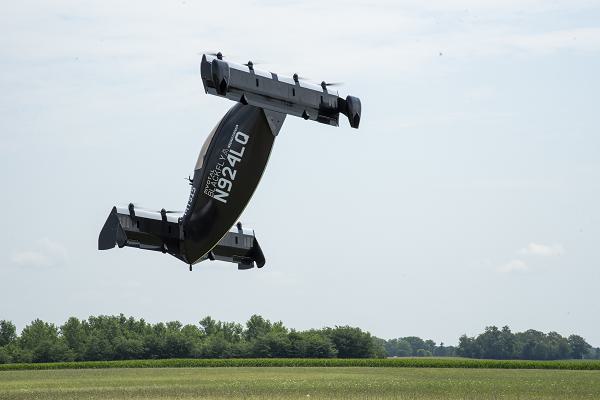
Springfield-Beckley Airport, Ohio. (August 12, 2024): The first time this aircraft flew over California, local authorities received hundreds of 911 calls about UFO sightings. What these startled civilians were witnessing was the maiden flight of the Blackfly, an electric powered super drone being developed for the Air Force. In this photo by Matthew Clouse, Ohio-based defense contractor Modern Technology Solutions Inc. launches its latest creation, the vertical take-off and landing aircraft called the Blackfly. The plane was developed as part of the AFWERX Agility Prime program to accelerate emerging technologies. AFWERX is the innovation arm within the Air Force Research Laboratory charged with translating the newest innovations into tools for America’s warfighters.
This sleek single seat aircraft, which also comes in an unmanned configuration, has eight propulsion motors, four on each wing. It has a V-shaped tail and a streamlined fuselage that gives it an out-of-this-world appearance. The craft takes off vertically, so it needs very little space to operate making it ideal for confined areas. The plane ascends to a comfortable altitude before transitioning from vertical to forward flight. Its engines produce an impressive nine hundred pounds of thrust and the plane has a range of over forty miles. The Blackfly cruises at sixty-two mph and can carry payloads up to 250 pounds. Oddly, the plane lands on its belly assisted by four small, fixed struts on the bottom end of each wing to protect them from hitting the ground.
The Air Force envisions using this unique craft to conduct surveillance and to transport critical materials quicker and with less noise than a traditional helicopter. In case you are interested in owning one, there is a civilian version available at a base price of $190,000.
- Details
- Hits: 3140
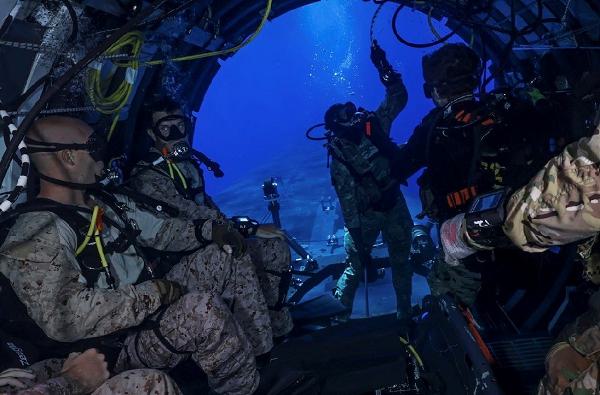
Mediterranean Sea. (August 17, 2024): Have you ever wondered how the U.S. Navy deploys and recovers special forces using submarines? In this photo by Petty Officer 2nd Class Almagissel Schuring, U.S. Marines from the 2nd Force Reconnaissance Company, assigned to Task Force 61/2, conduct dive training aboard the Ohio-class guided-missile submarine USS Georgia. The USS Ohio has a detachable Dry Deck Shelter that houses and deploys divers allowing easy exit and entrance while the boat is submerged.
Ever since Jules Verne’s fictional Nautilus, the Navy’s ability to deploy frogmen from submerged submarines has captured the public’s imagination. Frogmen in World War II conducted clandestine operations from the diesel-electric submarines of the period and today’s divers have a specially equipped “Lock Out trunk” that allows divers to remain dry as they transport to their launch site, don wetsuits and dive gear, and then exit and return to the sub undetected. The chamber, which can hold up to fourteen special operators, is filled with water until the pressure in and outside the ship equalizes allowing the hatch to open. Once outside, special forces access an operations box that contains their weapons and gear for the mission.
These Lock Out Trunks have multiple compartments for specific purposes. The forward-most compartment is a hyperbaric chamber used for treatment of injured divers. In the middle compartment, or transfer trunk, operators enter and exit the submarine and/or either of the other compartments. The third compartment is a hangar that houses either a SEAL Delivery submersible or a Combat Rubber Raiding Craft. To get back to the sub, Special Operators follow a pinging sonar that guides them back to the shelter once the mission is complete.
The Dry Deck Shelter can also be used to rescue the crew of a downed sub at depths up to six hundred feet. The hatch can release two crewmen at a time wearing survival suits through these special airlocks. With an expected forty-year service life, Dry Deck Shelters will likely continue to support the missions of Special Operations Forces for many years to come.
- Details
- Hits: 1231
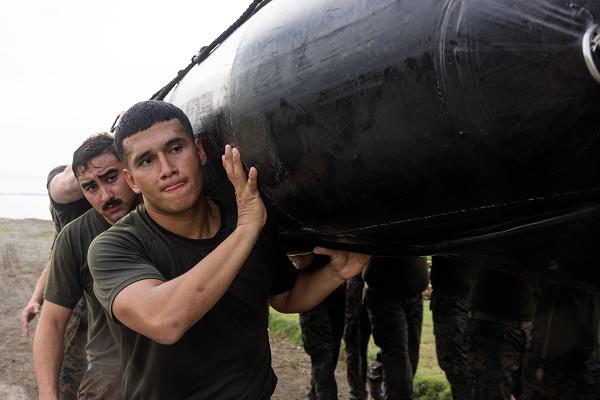
Apartado, Colombia. (August 13, 2024): When the U.S. Marines want to train with experts at riverine warfare, they turn to Columbia with its vast jungles and fast-moving rivers. In this photo by Corporal Trystan Taft, Marines with Littoral Craft Company Charlie, 4th Assault Amphibian Battalion, 4th Marine Division, carry a boat during the swim qualification portion of the Colombian Fluvial Operations Course. The Course consists of multiple training exercises including swim qualification, classroom lectures, weapons handling and maintenance, and littoral craft maneuvers. The course is divided into three-week intervals with the first week comprised of classroom instruction to familiarize Marines with the different Columbian Littoral crafts.
Columbia, with its half a million square miles of forests, grasslands, mountains, and jungles, is an ideal training venue for the Marines. The town of "Apartadó", meaning "river of plantains" in the local Indian language, is located near the Atlantic Ocean in the Gulf of Urabá. Its economy is based on bananas, plantain, corn, cassava, cocoa, wood, and livestock. The mean maximum temperature is a scorching eighty-six °F and the relative humidity is above 80% year-round.
- Details
- Hits: 1354
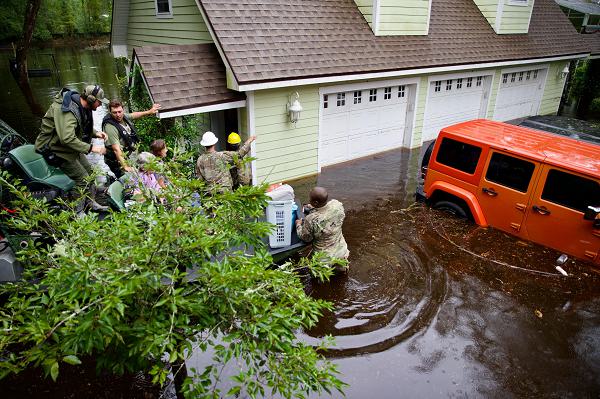
Live Oak, Florida. (August 14, 2024): If you are a National Guard Soldier serving in Florida, you know things are going to get dicey in the next few months. With the recent arrival of Hurricane Debby, the Florida National Guard has deployed across the state to support local communities and to help citizens in trouble. In this photo by Sergeant First Class Trinity Bierley, Soldiers from the 868th Engineer Company conduct a high-water rescue operation following flooding from Hurricane Debby. Florida’s Governor activated some 3,000 National Guard Soldiers on August 1st to prepare for the storm while declaring a state of emergency for sixty-one Florida Counties.
The deployment began with Soldiers from the 927th CSSB setting up shop in the State’s Logistics Resource Center, a facility that stores water, food, and other emergency supplies for distribution after the storm makes landfall. Additionally, the Guard’s 1st Battalion, 111th Aviation Regiment, prepared Black Hawk helicopters at the Tallahassee International Airport for support operations across the state. Other units, such as the 1-265th Air Defense Artillery Battalion, conducted route clearing and debris removal on city streets and supported an assisted living facility with its elderly and frail residents.
The Florida National Guard traces its heritage to 1565, the year the Spanish founders of St. Augustine organized their first company of citizen-Soldiers. Florida’s militia has defended local communities for over 440 years. The current Florida Army National Guard was established in 1907 and boasts almost 12,000 members including 450 state employees and nine hundred full-time Federal personnel. The Guard is made up of both Army and Air Force units and is headquartered at St. Augustine on the east coast.
The Army component includes the 53rd Infantry Brigade Combat Team, 50th Regional Support Group, the 83rd Troop Command, and the 164th Air Defense Artillery Brigade. The Guard also runs Camp Blanding, a Joint Training Center located outside of Jacksonville. The Air component includes the 125th Fighter Wing and the 101st Air and Space Operations Group.


